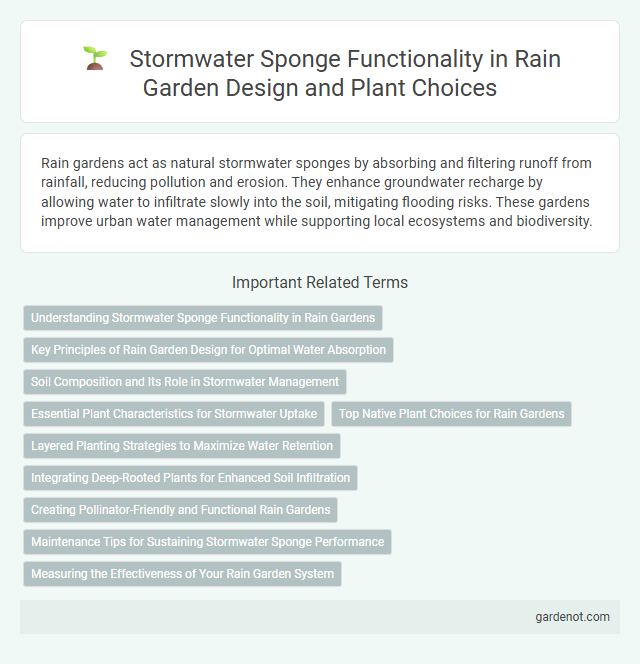Rain gardens act as natural stormwater sponges by absorbing and filtering runoff from rainfall, reducing pollution and erosion. They enhance groundwater recharge by allowing water to infiltrate slowly into the soil, mitigating flooding risks. These gardens improve urban water management while supporting local ecosystems and biodiversity.
Understanding Stormwater Sponge Functionality in Rain Gardens
Rain gardens act as effective stormwater sponges by capturing and infiltrating runoff from impervious surfaces, reducing surface water volume and improving water quality. The permeable soil and native vegetation facilitate the absorption and filtration of pollutants, promoting groundwater recharge while mitigating urban flooding. Functionality depends on proper design elements such as soil composition, gradient, and plant selection to optimize stormwater retention and enhance ecosystem services.
Key Principles of Rain Garden Design for Optimal Water Absorption
Rain gardens function as natural stormwater sponges by utilizing deep, permeable soils and native plants with extensive root systems to maximize infiltration and minimize runoff. Key principles include selecting site-specific plants adapted to local hydrology, ensuring proper soil amendment for enhanced water absorption, and designing basin contours to capture and slow stormwater flow effectively. Properly implemented rain garden designs improve groundwater recharge, reduce erosion, and filter pollutants from stormwater before it enters municipal systems.
Soil Composition and Its Role in Stormwater Management
Soil composition in a rain garden is crucial for optimizing stormwater infiltration and pollutant removal. A mix of sandy loam, organic matter, and clay enhances water retention, promotes microbial activity, and facilitates nutrient filtering. Properly engineered soil layers act as a natural stormwater sponge, reducing runoff volume and improving groundwater recharge.
Essential Plant Characteristics for Stormwater Uptake
Essential plant characteristics for stormwater uptake in rain gardens include deep root systems that enhance soil infiltration and water absorption. Plants with high transpiration rates effectively reduce standing water by transferring moisture back into the atmosphere. Native species adapted to local hydrology ensure resilience and maximize stormwater retention and pollutant filtration.
Top Native Plant Choices for Rain Gardens
Top native plants for rain gardens include switchgrass (Panicum virgatum), blue flag iris (Iris versicolor), and cardinal flower (Lobelia cardinalis), renowned for their exceptional stormwater absorption and filtration capabilities. These species thrive in moist conditions and possess deep root systems that enhance soil infiltration, reducing runoff and preventing erosion. Incorporating diverse native plants optimizes rain garden performance by promoting biodiversity and supporting local ecosystems.
Layered Planting Strategies to Maximize Water Retention
Rain gardens utilize layered planting strategies that incorporate deep-rooted native plants, herbaceous perennials, and ground covers to create a stormwater sponge effect, enhancing infiltration and water retention. These diverse vegetation layers improve soil structure and increase evapotranspiration rates, reducing runoff volume and mitigating urban flooding. Strategic layering supports microbial activity and soil aeration, optimizing the garden's capacity to absorb and filter stormwater efficiently.
Integrating Deep-Rooted Plants for Enhanced Soil Infiltration
Deep-rooted plants in rain gardens act as natural stormwater sponges by improving soil structure and increasing infiltration rates. Their extensive root systems create channels that facilitate deeper water penetration, reducing surface runoff and promoting groundwater recharge. Integrating species such as switchgrass, blueflag iris, and red osier dogwood enhances the rain garden's ability to manage stormwater efficiently while supporting soil health.
Creating Pollinator-Friendly and Functional Rain Gardens
Stormwater sponge rain gardens are designed to enhance stormwater management while promoting biodiversity by creating habitats for pollinators such as bees, butterflies, and hummingbirds. Incorporating native flowering plants with deep root systems not only improves water infiltration but also supports pollinator populations by providing nectar and shelter. These functional rain gardens mitigate runoff, reduce urban heat island effects, and strengthen local ecosystems through increased pollinator activity.
Maintenance Tips for Sustaining Stormwater Sponge Performance
Regular removal of sediment and debris from the stormwater sponge prevents clogging and maintains optimal infiltration rates. Periodic inspection and pruning of vegetation enhance plant health and filtration efficiency, ensuring sustained pollutant removal. Seasonal mulching replenishes soil nutrients and supports microbial activity critical for breaking down contaminants in stormwater.
Measuring the Effectiveness of Your Rain Garden System
Measuring the effectiveness of a rain garden as a stormwater sponge involves monitoring water infiltration rates and pollutant removal efficiency. Key metrics include the volume of stormwater captured, duration of ponding after rainfall, and reduction in runoff from impervious surfaces. Regular assessment through soil moisture sensors and water quality testing ensures optimal performance and informs maintenance needs.
Stormwater sponge Infographic

 gardenot.com
gardenot.com